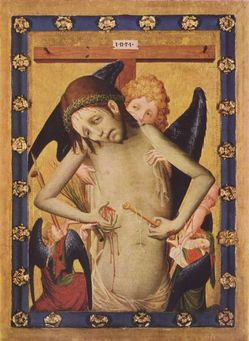In his Sermon on Palm Sunday Blessed Guerric of Igny (d. ca. 1157), tells us:
When Jesus entered Jerusalem like a triumphant conqueror, many were astonished at the majesty of his bearing; but when a short while afterward he entered upon his passion, his appearance was ignoble, an object of derision. If today’s procession and passion are considered together, in the one Jesus appears as sublime and glorious, in the other as lowly and suffering. The procession makes us think of the honor reserved for a king, whereas the passion shows us the punishment due a thief.
 In the one Jesus is surrounded by glory and honor, in the other “he has neither dignity nor beauty.” In the one his is the joy of men and women and the glory of the people, in the other “the butt of men and the laughing stock of the people.” In the one he receives the acclamation: “Hosanna to the Son of David! Blessed is he who comes as the king of Israel”; in the other there are shouts that he is guilty of death and he is reviled for having set himself up as king of Israel.
In the one Jesus is surrounded by glory and honor, in the other “he has neither dignity nor beauty.” In the one his is the joy of men and women and the glory of the people, in the other “the butt of men and the laughing stock of the people.” In the one he receives the acclamation: “Hosanna to the Son of David! Blessed is he who comes as the king of Israel”; in the other there are shouts that he is guilty of death and he is reviled for having set himself up as king of Israel.
In the procession the people meet Jesus with palm branches, in the passion people slap him in the face and strike his head with a rod. In the one they extol him with praises, in the other they heap insults upon him. In the one the people compete to lay their clothes in his path, in the other he is stripped of his own clothes. In the one he is welcomed to Jerusalem as a just king and savior, in the other he is thrown out of the city as criminal, condemned as an imposter. In the one he is mounted on an ass and accorded every mark of honor, in the other he hangs on the wood of the cross, torn by whips, pierced with wounds and abandoned by his own. If, then, we want to follow our leader without stumbling through prosperity and through adversity, let us keep our eyes upon him, honored in the procession, undergoing ignominy and suffering in the passion, yet unshakeably steadfast in all such changes of fortune.
Lord Jesus, you are the joy and salvation of the whole world; whether we see you seated on an ass or hanging on the cross, let each one of us bless and praise you, so that when we see you reigning on high we may praise you forever and ever, for to you belong praise and honor through all ages. Amen.




